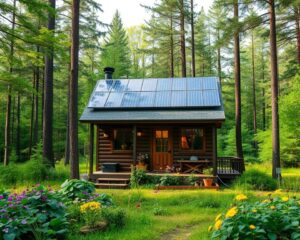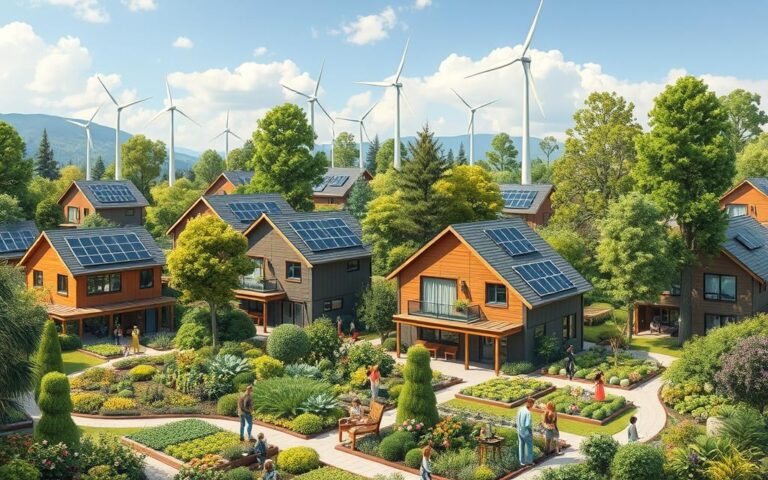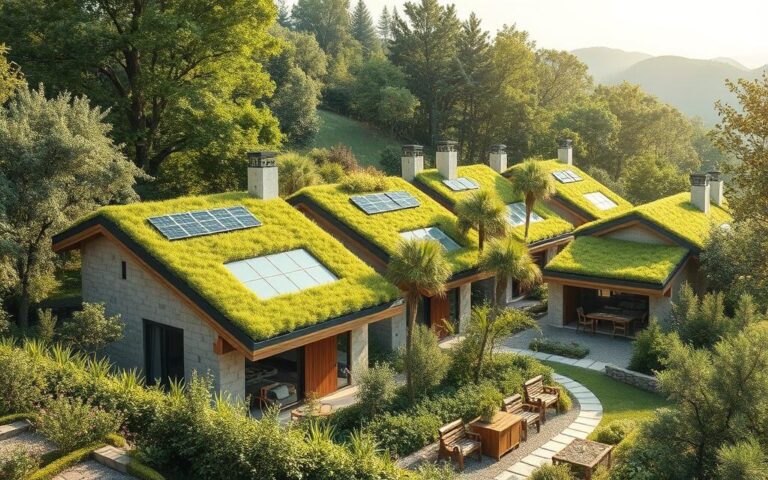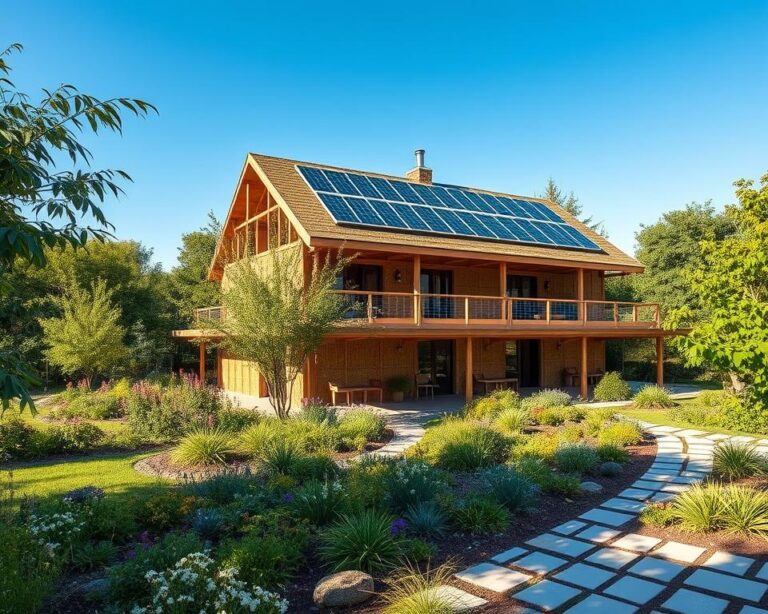Did you know tiny homes are usually between 100 to 400 square feet? This small living style is a smart choice for saving money and living green. The Tiny House Movement makes you think differently about what a home is. It focuses on simple, eco-friendly homes.
More people want affordable homes, and tiny houses offer that. By choosing a smaller home, you can cut your environmental impact by up to 45%!
This movement is about valuing what’s important, not just how big your space is. Tiny houses mean living simply and sustainably. They’re perfect for remote workers or anyone wanting to own less.
In the next parts, we’ll explore the good, the features, and the challenges of tiny house living. We’ll help you on your path to a greener life.
What Is the Tiny House Movement?
The Tiny House Movement is gaining popularity, showing a big change in how we think about homes. It’s all about living small but not sacrificing comfort. Tiny houses are usually under 400 square feet, making them easy to maintain and affordable.
Definition and Overview
This movement believes that smaller living spaces can make life more fulfilling. It helps people focus on experiences, not stuff. Over half of Americans are interested in tiny houses, seeing them as a good first home option.
Housing prices keep going up, making tiny houses even more appealing.
Historical Background
The Tiny House Movement isn’t new; it’s inspired by old ways of living. Back then, people lived in small homes because they had to. They valued community and sustainability.
Now, it’s about wanting to live that way again. It’s about feeling free and tackling the housing crisis.
Benefits of Tiny House Living
The Tiny House Movement is gaining fans who want a simpler, more affordable life. It’s not just about saving money; it’s also good for the planet. Living small means less clutter and more focus on what’s important.
Affordability
One big plus of tiny houses is how affordable they are. Prices range from $30,000 to $60,000, which is much cheaper than regular houses. This means less stress about money and lower bills for upkeep.
Plus, tiny homes use less energy, which saves you money on utilities. You can use that extra cash for fun or saving.
Reduced Environmental Impact
Going tiny means a smaller carbon footprint. Tiny houses need less energy for heating and cooling. They also use fewer materials to build, which is better for the planet.
Many builders, like Modern Tiny Living, focus on making tiny homes sustainable. They help you live greener without sacrificing style.
Simplicity and Minimalism
The Tiny House Movement is all about simplicity. Living small forces you to choose what’s truly important. It means less stuff to clean and more time for what matters.
By focusing on experiences and people, not things, you might find more joy. It’s a chance to live more intentionally and without clutter.
| Aspect | Tiny House Living | Traditional Housing |
|---|---|---|
| Cost | $30,000 – $60,000 | Typically over $200,000 |
| Carbon Footprint | Much smaller | Larger |
| Utility Bills | Significantly lower | Higher |
| Cleaning Time | Less time spent | More time spent |
| Customization | Easy to customize | More time-consuming |
Exploring the Tiny House Movement reveals a lifestyle that’s affordable, eco-friendly, and simple. It’s a chance to live more intentionally and enjoy life’s basics.
Key Features of Tiny Houses
Tiny houses have amazing features that make them stand out. They focus on small space design, space optimization, and energy efficiency. These homes turn small spaces into cozy homes that are good for the planet.
Space Optimization
Tiny houses use space in creative ways. They are usually between 100 and 400 square feet. The designs use vertical space and mix different areas for function.
This makes the space feel bigger and connects you with nature. Tiny homes have multi-purpose furniture and smart storage. This means you can live comfortably without wasting space.
Energy Efficiency
Energy efficiency is key in tiny house design. They use eco-friendly materials and save energy. This means lower bills and less harm to the environment.
Natural light and good insulation keep the house warm or cool. This shows how tiny houses are good for the planet.
Innovative Storage Solutions
Storage in tiny houses is cleverly designed. There are shelves, benches, and under-bed storage. This keeps things tidy without taking up space.
The simple design encourages choosing items that do more than one thing. This saves space and makes the home look good.
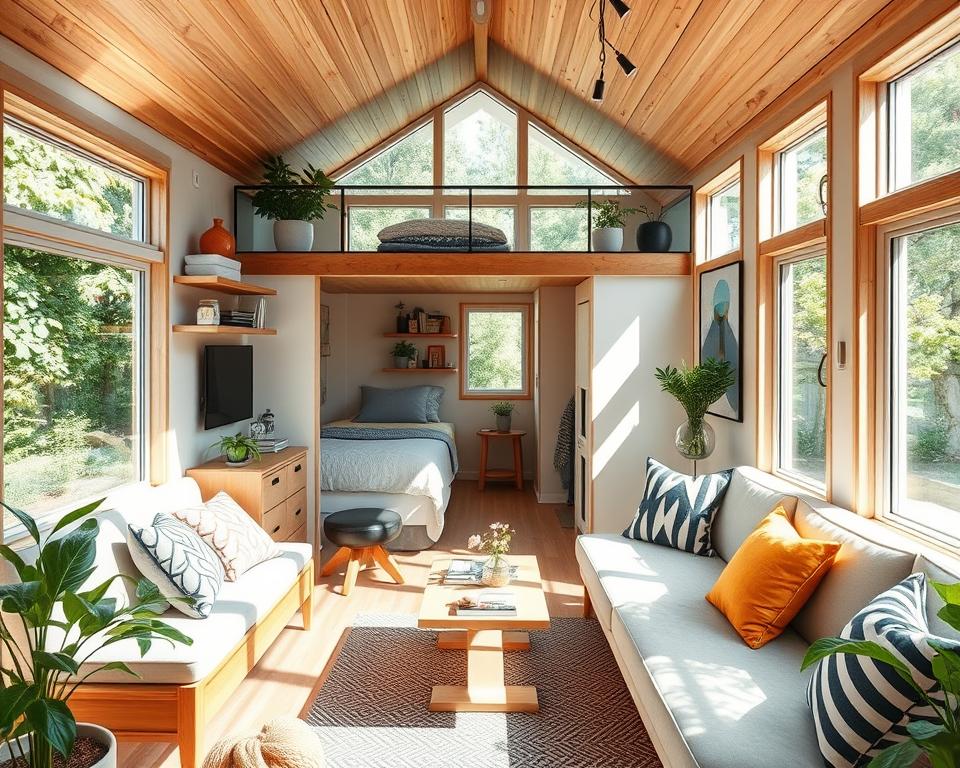
Getting Started in the Tiny House Movement
Starting your tiny house journey requires careful planning. First, do a tiny home assessment to figure out what you need. Knowing what you like in a space helps with design choices.
Assessing Your Needs
Thinking about tiny living means looking at your personal needs. Important things to think about include:
- Current belongings and how they will fit into a smaller space.
- Your lifestyle and if it fits with a simpler way of living.
- Future plans that might need a flexible living space.
Most tiny houses are under 600 square feet. This size offers a unique living experience. Your choices in tiny house construction depend on your personal assessment.
Budgeting for Your Tiny Home
Money matters a lot in the tiny house world. Building your own tiny home can be much cheaper than buying a regular house. On average, a tiny home built by the owner costs about $23,000. This is a big difference from the average price of a regular house, which is around $272,000.
Here are some financial things to think about:
| Cost Category | Tiny House | Traditional House |
|---|---|---|
| Average Cost | $160,000 | $425,000 |
| Typical Size | 100-400 sq ft | 2,600 sq ft |
| Annual Carbon Emissions | 2,000 lbs | 28,000 lbs |
| Debt-Free Living | 68% of owners | 29.3% of homeowners |
Living in a tiny house can also save you money on utilities and upkeep. This savings, along with a simpler lifestyle, can make for a more rewarding life.
Choosing the Right Location for Your Tiny House
Finding the perfect tiny house location means knowing about local zoning laws and what you want in terms of mobility or staying put. You need to look at the rules each state has for tiny homes. Many places have rules that limit where you can put a tiny house.
Zoning Laws and Restrictions
Starting your tiny house journey means looking into local zoning laws. Many places require homes to be at least 400 square feet to be called a tiny house. Colorado has strict rules for tiny homes on wheels, but Texas is more flexible, especially outside cities.
In Florida, some counties have easy rules for building tiny homes. This makes it a great place for creative living. North Carolina requires tiny homes to follow the state’s building code for safety. Utah cities like Salt Lake allow tiny homes as accessory dwellings on residential land.
It’s important to check these laws to make sure your tiny house fits in with the community.
Mobile vs. Permanent Placement
Choosing between a mobile home and a permanent tiny house changes your lifestyle. Mobile homes let you move around, exploring different places. They are often seen as RV trailers and can be parked in places where camping is allowed.
- Mobile homes offer freedom and mobility.
- Permanently placed tiny houses may enhance community engagement.
- Certain rural areas near metropolitan regions are more accommodating for tiny living.
When looking for a permanent spot, think about areas that allow backyard tiny homes. These can follow rules for accessory dwelling units. But, you might also look into variances in local planning departments. This option can be risky and depends on local rules.
Sustainable Living Practices within the Movement
The Tiny House Movement is all about living green. It teaches us to lessen our environmental footprint. By choosing eco-friendly materials and living in smaller spaces, we help the planet and live simpler lives.
Eco-Friendly Materials
Building tiny homes often means using green materials. These materials are key to living sustainably. Some popular ones are:
- Thermally modified wood
- Recycled steel
- Reclaimed wood
- Low-VOC paints and finishes
These materials cut down on waste and last longer. Big Tiny, for example, combines modern comforts with green building. They help reduce the environmental harm of traditional building and make homes healthier.
Off-Grid Living Options
Off-grid living is big in the tiny house world. It uses renewable energy and systems that don’t rely on public utilities. Tiny homes often have:
- Solar panels
- Composting toilets
- Rainwater harvesting systems
These features help you be self-sufficient and live simply. They lower your costs and carbon footprint. Off-grid living also brings you closer to nature and teaches you to conserve resources.
| Feature | Traditional Homes | Tiny Homes |
|---|---|---|
| Size | Over 1,500 sq ft | 100 – 400 sq ft |
| Building Materials | Conventional materials | Eco-friendly materials |
| Energy Efficiency | Moderate | High |
| Mobility | Fixed | Mobile or fixed |
| Environmental Impact | Higher | Lower |
Choosing tiny houses for sustainable living has many benefits. It reduces our environmental impact and teaches us to make conscious choices. These choices greatly affect our lifestyle and well-being.
Community and Social Aspects of Tiny House Living
The tiny house movement is more than downsizing. It’s about building a community that connects and works together. Living in tiny house communities offers a chance to interact and share resources. This helps everyone feel better and live more sustainably.
Finding Tiny House Communities
Many tiny house communities are welcoming places where people form strong bonds. For example, Lakeland Ridge Tiny Home Community in Bean Station, Tennessee, has space for up to 50 tiny houses. It’s a tight-knit community.
Places like Tiny Timbers Agrihood in St. Croix, Wisconsin, have shared spaces like gardens and orchards. These areas help strengthen the social ties among tiny house residents.
Networking Opportunities
In these communities, people share knowledge and experiences freely. They help each other out in many ways, like sharing meals or childcare. This reduces feelings of loneliness and isolation.
Being part of a community makes people feel more connected. It encourages them to join in on activities like gardening or renewable energy projects. This sense of belonging is key to happiness and well-being.
Being involved in community activities can make life less stressful. It shows that tiny house communities are not just homes but also places of support and connection. As more people embrace this way of living, it will change how we think about housing and community.
| Aspect | Tiny House Communities | Traditional Housing |
|---|---|---|
| Sense of Community | High | Variable |
| Resource Sharing | Common | Rare |
| Social Support | Strong | Weak |
| Networking Opportunities | Frequent | Occasional |
Challenges of the Tiny House Movement
Switching to tiny house living comes with its own set of challenges. At first, the idea of less space might seem appealing. But, it requires big changes in how you live. You’ll need to downsize and get better at organizing your space.
Limited Space
Typically, tiny homes are between 200 and 400 square feet. This means you have to rethink how you view your stuff. Downsizing can feel freeing, but it might also make you feel trapped or uncomfortable. Living small requires careful planning and adjusting to less space.
Also, moving often can make it hard to feel settled. This is especially true if you value having your own space.
Financing and Insurance Issues
Getting a mortgage for a tiny home can be tough. Banks often don’t lend for these unique homes. Building a tiny home usually costs between $20,000 and $80,000. So, people might look for loans meant for RVs or personal use.
Insurance is another problem. Tiny homes don’t fit into the usual property categories. This makes getting full coverage hard. Knowing about these financial hurdles is key to a smooth move to tiny living.
Personal Stories from Tiny House Dwellers
Many people living in tiny houses share inspiring stories. They talk about how simplifying life can bring joy and fulfillment. These stories often include overcoming challenges, building community, and feeling free from money worries.
Inspirational Journeys
A couple moved from a big house to a tiny one. Their new home, with an 8’ bi-fold window and special storage, became a creative space. They documented their journey, showing the excitement and learning of building their tiny home.
After living in the tiny house, they found their big house felt too big. They started to get rid of things they didn’t need. They went from 30 drinking glasses to four and gave away many books. They wanted to get rid of almost 80% of their stuff, following the 80/20 rule.
They planned their tiny house for five months but built it in just two weeks. This experience made them want to live more simply.
Lessons Learned
Living in a tiny house is a personal journey with valuable lessons. The writer of The Tiny House Concierge started this adventure during the pandemic. They moved from a hotel room to storing their tiny home in Texas.
This experience led to new ideas and writing opportunities. Family members were interested in sustainability and minimalism. This sparked important conversations about what we really need.
These stories remind us of what’s truly important in life. They show how tiny living focuses on experiences and relationships, not possessions. Many say it teaches us to value what really matters, encouraging us to think about our own experiences and lessons from tiny living.
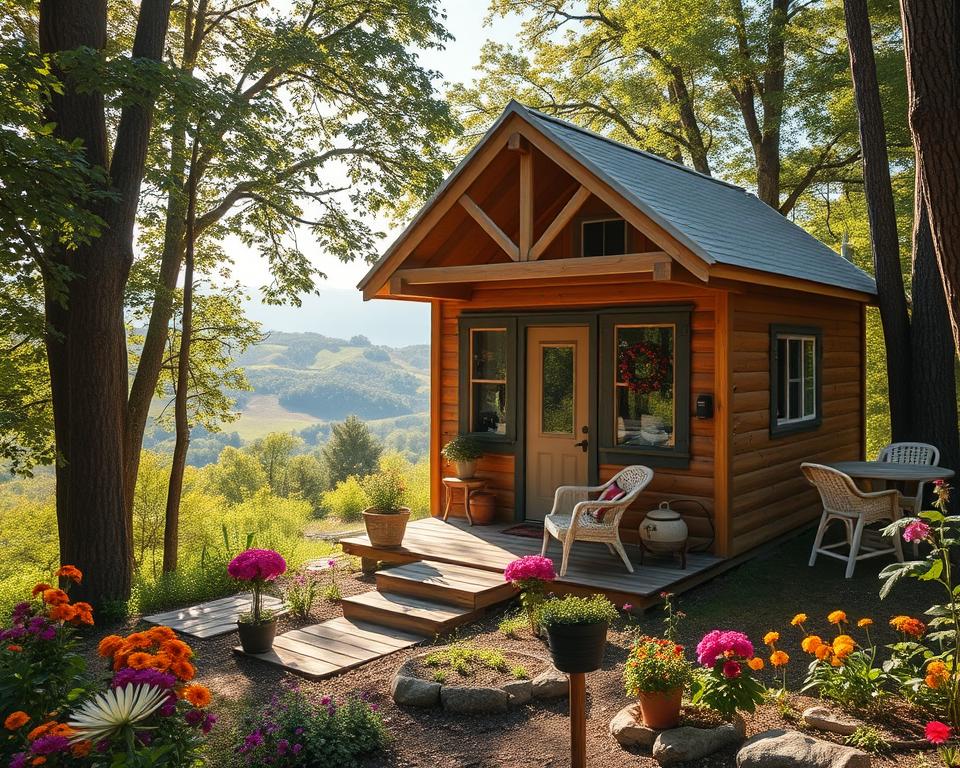
The Future of the Tiny House Movement
The tiny house movement is on a complex path, especially with the push for sustainability. Although it has seen a drop in media attention, a dedicated group still values the minimalist lifestyle. They see it as a way to save money and live freely.
Looking ahead, trends in sustainable housing are emerging. These trends include new designs and making tiny homes more accessible. They promise to change the movement for the better.
Trends to Watch
Watch for new eco-friendly building materials and construction methods. These advancements are making tiny homes more sustainable. Off-grid living is also becoming more popular, attracting those who want to lessen their environmental impact.
With traditional homes costing over $320,000, tiny houses are becoming a more affordable option. They cost between $10,000 and $60,000. This could lead to a 45% reduction in energy use compared to larger homes.
Potential for Growth
The tiny house movement is expected to grow to $5.8 billion by 2025. Millennials and retirees are driving this growth, seeking affordability and mobility. Yet, zoning laws and practical issues like storage and privacy remain challenges.
There’s a growing focus on building communities and sharing resources. This could spark renewed interest in tiny living. As society evolves, the future of tiny living looks promising for those embracing simplicity and sustainability.

